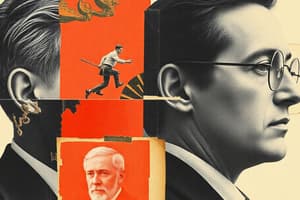Podcast
Questions and Answers
What did John Maynard Keynes believe about government intervention?
What did John Maynard Keynes believe about government intervention?
- It always leads to recession
- It can affect output and employment (correct)
- It should not intervene
- It only creates problems
What are the three factors of production identified by Adam Smith?
What are the three factors of production identified by Adam Smith?
Land, labor, and capital
Classical economics advocates for government intervention in the economy.
Classical economics advocates for government intervention in the economy.
False (B)
What principle states that supply creates its own demand?
What principle states that supply creates its own demand?
What was the U.S. unemployment rate in 1933?
What was the U.S. unemployment rate in 1933?
Who studied economics but did poorly on his exams?
Who studied economics but did poorly on his exams?
The Keynesian view suggests that full employment is the natural state of the economy.
The Keynesian view suggests that full employment is the natural state of the economy.
What type of policy did Keynes advocate during economic downturns?
What type of policy did Keynes advocate during economic downturns?
What economic theory emphasizes marginal analysis?
What economic theory emphasizes marginal analysis?
The principles of Classical Economics emerged during and after __________.
The principles of Classical Economics emerged during and after __________.
What does the Phillips Curve illustrate?
What does the Phillips Curve illustrate?
Flashcards are hidden until you start studying
Study Notes
The Roots of Macroeconomics
- John Maynard Keynes published The General Theory of Employment, Interest, and Money in 1936.
- Keynes advocated for government intervention in the economy to influence output and employment levels.
- In times of low private demand, increased government spending can raise aggregate demand and help recover from recessions.
Classicalists
- Adam Smith's The Wealth of Nations (1776) highlighted land, labor, and capital as the key factors of production and contributors to a nation's wealth.
- Smith introduced the concept of the "invisible hand," suggesting that individual self-interest leads to societal benefits.
- Thomas Malthus in Essay on the Principle of Population (1798) warned of geometric population growth outpacing arithmetic food production, leading to low living standards.
- David Ricardo's On the Principles of Political Economy and Taxation (1817) addressed income distribution conflicts among landowners, laborers, and capitalists, emphasizing how limited land availability increases rents while suppressing wages.
Classical Economics Ideas
- Emerged during and after industrialization, focusing on market efficiency and self-regulation.
- Belief that government intervention hinders economic growth; the market autonomously adjusts to fluctuations.
- Supply equals demand; production increases stimulate economic activity.
- Advocated for private property, competition, and a general distrust of government involvement.
Neo-Classicalists
- Neo-classical economics builds upon classical principles incorporating mathematical models and firm theories.
- Alfred Marshall's Principles of Economics (1890) was pivotal in introducing marginal analysis.
- Neo-classicalists shifted the focus from production costs determining prices to supply and demand dynamics.
Classicalists & Neo-Classicalists
- Both groups support unimpeded market functions leading to economic prosperity.
- Shared belief that government intervention is only necessary to address market imperfections.
- Classicalists viewed an unregulated market as self-tending toward full employment.
Say's Law: Supply Creates Its Own Demand
- Economic flow described as: Supply → Production → Income → Savings/Investment → Spending → Demand.
UK Unemployment Rates (1921-1938)
- Average unemployment was 14.2% during this period, peaking at over 22% in 1922.
- The best year was 1927, with unemployment dipping below 10% (1.1 million people).
U.S. Unemployment Rate (Great Depression)
- Unemployment rates surged from 3.2% in 1929 to 24.9% in 1933, reflecting the economic crisis' severity.
Great Depression Impact
- GNP plummeted by 30% from 1929 to 1933, with government tax revenues falling by 50%.
- Hoover increased top marginal tax rates significantly from 25% to 63%.
- By 1933, machine tool orders had diminished to 1/8 of 1929 levels, with over 9,000 banks closing.
John Maynard Keynes
- Despite early academic struggles, Keynes became an influential economist, lecturing at King’s College and editing the Economic Journal.
- He worked for the Treasury during WWI and was involved in the Treaty of Versailles negotiations.
- By 1944, he led the British delegation at the Bretton Woods Conference.
Keynesian View
- Suggested that full employment is not a guaranteed market outcome; equilibrium can exist at high unemployment levels.
- Argued unemployment results from demand deficiencies, which can be addressed through expansionary fiscal policies.
Keynesian Economics
- Critiqued the idea of a self-sustaining market, noting possible equilibria with unemployment and stagnation.
- Emphasized that consumer income drives demand, essential for economic growth.
- Recommended government intervention to stimulate demand during periods of economic decline.
Keynesian Policy Measures
- Expansionary fiscal policy favored, arguing tax cuts might lead to savings rather than consumption; thus, government spending was prioritized.
- Government action is recommended when consumer confidence ('animal spirits') declines, which suppresses demand.
Keynesian Demand Management (Post World War II)
- Introduced the Phillips Curve, illustrating the trade-off between inflation and unemployment.
- Suggested that rising inflation or trade deficits might warrant reduced aggregate demand through deflationary fiscal policies, such as tax increases or spending cuts.
UK Economic Landscape Post-1945
- Created a welfare society balancing private sector (retail, industries) and state sector (nationalized industries like coal and steel).
- The economy saw collaboration between market forces and government initiatives to strengthen overall societal welfare.
Studying That Suits You
Use AI to generate personalized quizzes and flashcards to suit your learning preferences.




